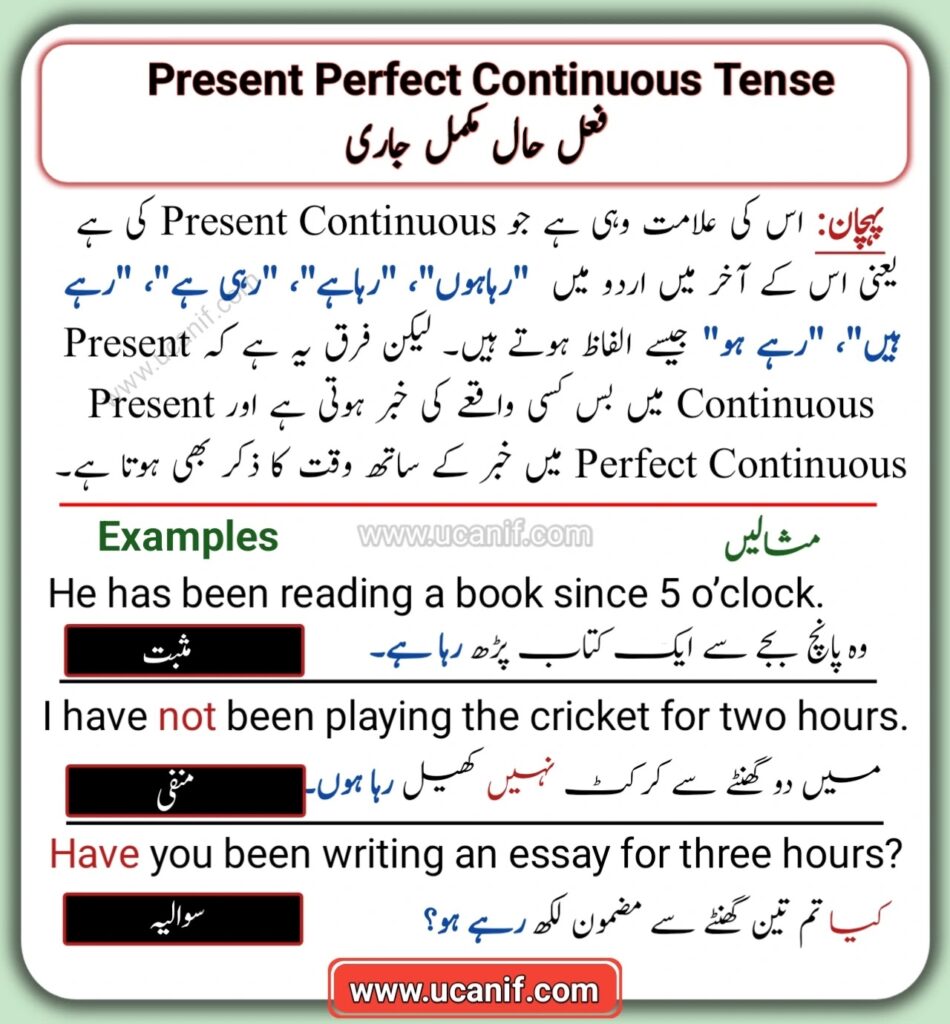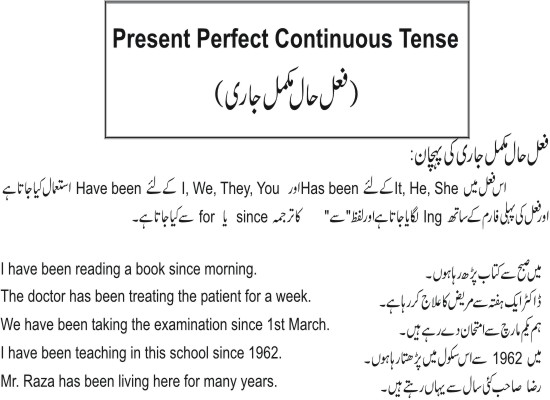Urdu, one of the richest languages known for its poetic charm and harmonious script, can offer a fascinating journey of linguistic exploration. One critical aspect of this journey involves understanding the use of verb tenses, specifically the Present Perfect Continuous Tense. This article will help you unravel the nuances of this particular tense in Urdu and gain confidence in your language proficiency.

Present perfect continuous tense rules in Urdu
The verb form used is subject to the gender, number, and person of the subject. For example, for masculine singular subjects, ‘رہا ہوں’ is used, for feminine singular ‘رہی ہوں’ and for plural subjects ‘رہے ہیں’.
- Subject: The subject can be a pronoun or a noun, e.g., “میں” (I), “تم” (you), “وہ” (he/she), “ہم” (we), “بچے” (children), “سارہ” (Sarah), etc.
- Duration of Time: This represents the time period for which the action has been ongoing. It could be specific or general, e.g., “ایک گھنٹہ” (an hour), “دو دن” (two days), “کچھ سال” (some years), etc.
- Root form of Verb: Use the base form of the verb that represents the ongoing action. For example, “پڑھ” (read), “کھا” (eat), “سو” (sleep), etc.
- رہا/رہی/رہے: These denote the ongoing action. “رہا” is used with singular masculine subjects, “رہی” with singular feminine subjects, and “رہے” with plural subjects.
- ہوں/ہے/ہیں: These are used to represent the present tense. “ہوں” is used for the first person singular, “ہے” for third person singular, and “ہیں” for plural subjects.
Here are some examples to illustrate these rules:
- “میں پچھلے ایک گھنٹے سے کتاب پڑھ رہا ہوں۔” (I have been reading a book for the past hour.)
- “وہ دو دنوں سے بیمار ہیں اور سو رہی ہے۔” (She has been sick and sleeping for two days.)
- “ہم پانچ سالوں سے یہاں رہ رہے ہیں۔” (We have been living here for five years.)
How to form the present perfect continuous tense in Urdu?
In Urdu, the present perfect continuous tense, also known as “موجودہ کامل استمراری وقت,” is used to indicate an ongoing action that started in the past and continues in the present. To form this tense, you would typically use the following structure:
[Subject] + [Duration of Time] + [Root form of Verb] + [رہا/رہی/رہے] + [ہوں/ہے/ہیں]
Let’s break down the structure:
- [Subject]: This could be a noun or pronoun like “میں” (I), “تم” (You), “وہ” (He/She), etc.
- [Duration of Time]: This refers to the time period during which the action has been ongoing. For instance, “ایک گھنٹہ” (one hour), “دو دن” (two days), “چند سال” (few years), etc.
- [Root form of Verb]: This is the base form of the verb, such as “کھانا” (to eat), “سونا” (to sleep), “پڑھنا” (to read), etc.
- [رہا/رہی/رہے]: This is attached to the verb root to indicate the action is ongoing. Use “رہا” for masculine singular subjects, “رہی” for feminine singular subjects, and “رہے” for plural subjects.
- [ہوں/ہے/ہیں]: This is attached at the end of the sentence to show the present tense. Use “ہوں” for first person singular, “ہے” for third person singular, and “ہیں” for plural.
Here are some examples:
- “میں دو گھنٹے سے پڑھ رہا ہوں۔” (I have been reading for two hours.)
- “سارہ تین مہینے سے کام کر رہی ہے۔” (Sarah has been working for three months.)
- “بچے کچھ ہفتوں سے کھیل رہے ہیں۔” (The kids have been playing for a few weeks.)

Present perfect continuous tense in Urdu for beginners
Start with simple sentences and gradually move towards complex sentences, always bearing in mind the rules related to the subject.
Learning the present perfect continuous tense in Urdu might initially seem complex to beginners, but with clear understanding and consistent practice, you can easily master it.
The present perfect continuous tense (موجودہ کامل استمراری وقت) in Urdu expresses an action that started in the past and is still ongoing. Here’s a simple structure to form sentences in this tense:
[Subject] + [Duration of Time] + [Root form of Verb] + [رہا/رہی/رہے] + [ہوں/ہے/ہیں]
The usage of رہا/رہی/رہے depends on the gender and number of the subject. رہا is for masculine singular, رہی is for feminine singular, and رہے is for plural subjects.
For beginners, let’s start with some simple sentences:
- “میں ایک گھنٹے سے پڑھ رہا ہوں۔” (I have been reading for an hour.)
- “سارہ دو گھنٹوں سے سو رہی ہے۔” (Sarah has been sleeping for two hours.)
- “بچے تین دنوں سے کھیل رہے ہیں۔” (The kids have been playing for three days.)
Present perfect continuous tense in spoken Urdu
In spoken Urdu, this tense is commonly used to indicate long-standing habits, ongoing actions, and tasks with a specific duration.
The present perfect continuous tense, also known as “موجودہ کامل استمراری وقت” in Urdu, is commonly used in everyday spoken Urdu to indicate an action that started in the past and continues in the present. It’s a convenient way to communicate the duration of an ongoing action.
Here are some examples of the present perfect continuous tense used in spoken Urdu:
- “میں ابھی تک کتاب پڑھ رہا ہوں۔” (I have been reading the book up till now.)
- “ہم تین گھنٹے سے یہاں انتظار کر رہے ہیں۔” (We have been waiting here for three hours.)
- “تم کتنے دنوں سے یہ کام کر رہے ہو؟” (How many days have you been doing this work?)
- “وہ بچپن سے ہی پیانو بجا رہی ہے۔” (She has been playing the piano since her childhood.)
- “میں چھ مہینے سے اردو سیکھ رہی ہوں۔” (I have been learning Urdu for six months.)

Present perfect continuous tense in Urdu literature
Urdu literature is replete with examples of this tense, bringing richness to storytelling and poetry.
The usage of the present perfect continuous tense in Urdu literature adds depth to the narratives and helps in expressing the duration of ongoing actions or states in the story. This form is frequently used in Urdu novels, short stories, dramas, and even poetry to convey sustained actions and evoke certain emotions.
For instance, a character in a novel might say, “میں بچپن سے یہی شہر میں رہ رہا ہوں۔” (I have been living in this city since my childhood.)
Or in a drama script, you might come across a line like, “وہ تین سالوں سے میری مدد کر رہا ہے۔” (He has been helping me for three years.)
Present perfect continuous tense in Urdu conversation practice
Practice speaking in Urdu with peers, teachers, or language partners, focusing on the usage of this tense.
Practicing conversational Urdu is a fantastic way to master the present perfect continuous tense. Here are a few examples that you can use for your practice:
- “میں تین سال سے اردو سیکھ رہی ہوں۔” (I have been learning Urdu for three years.)
- “تم کتنے ہفتوں سے یہ کتاب پڑھ رہے ہو؟” (How many weeks have you been reading this book?)
- “وہ دو مہینے سے گٹار بجا رہا ہے۔” (He has been playing the guitar for two months.)
- “ہم تین گھنٹوں سے بارش کا انتظار کر رہے ہیں۔” (We have been waiting for the rain for three hours.)
- “آپ کب سے انگلش سیکھ رہے ہیں؟” (Since when have you been learning English?)
While practicing these sentences, remember to keep the gender and number agreement rules in mind. The more you converse in Urdu using the present perfect continuous tense, the more naturally it will come to you. You could also find a language partner or join a language learning group to get more practice. Happy learning!


